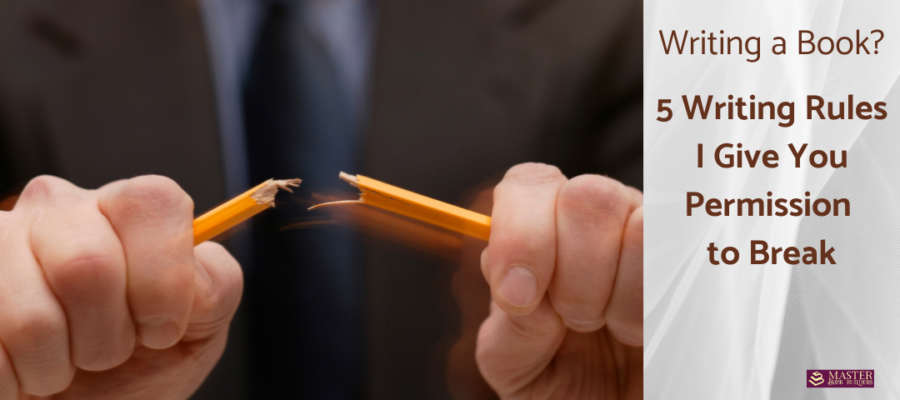5 Rules You Can and Should Break as a Writer – Yes, I Give You Permission
Oh the horror of it!
Who can remember back to 5th grade when you were anxiously waiting for the return of your creative writing story, hoping beyond hope for that A, only to be faced with a B+?
A stinking B+.
What is anyone to do with a B+ when you slaved for hours over that story; you wrote and rewrote and filled up a gigantic wastebasket with crumpled-up paper? You wore your pencil to a nub (no typewriters or computers back then – certainly not in the average American household), working hard to get everything right.
I remember. I remember feeling the flush come up my face, even though no one was paying me any mind. I remember thinking, “Why? What did I do wrong?” And then, I had to force myself to look down at the paper and look at the red editing marks Mrs. Mutts had put there.
And, yes, there they were. The measly culprits – the reasons my teacher graded that paper less than an A. It especially hurt me because I never got less than an A in creative writing.
I was a student of reading, after all. Being such a student, I knew all about things like commas and quotation marks and when a question wasn’t a question. So, why all of the red marks in this story – well, they were for rules in writing and grammar that I broke then and continue to break now. Let me share them with you.
The 5 Rules You May Break, but Only if…You Know HOW and WHY You are Breaking Them
- We’ll start with the common run-on sentence. Honestly, if Hemingway were here, he’d be laughing all the way across the room to the bottle of whiskey stashed in his bureau, being almost noon somewhere and all.
A run-on sentence is when two independent clauses run together without proper punctuation or conjunctions. Easy definition. Be a good writer. Write sentences properly. Use lots of periods and commas only occasionally. Don’t be boring, though. Be creative.
Maybe being creative means when you’re writing – be it fiction or nonfiction – you don’t let this rule dictate your prose. Sometimes you gotta say what you gotta say even when they say you can’t. Just keep it in check, please. You are not Charles Dickens:
“It was the best of times, it was the worst of times, it was the age of wisdom, it was the age of foolishness, it was the epoch of belief, it was the epoch of incredulity…” and on and on he goes.
Charles Dickens, A Tale of Two Cities
Can you do that? Be Dickens or Faulkner? Perhaps. Let your developmental editor guide you.
2. Starting a sentence with a conjunction. This is my favorite rule to break. And I do it all the time. The key is to be effective. It was not effective just now. Using a conjunction to begin a sentence is one way to create continuity or emphasize a point. I often use it to convey a casual or informal tone. That’s how I like to roll.
3. Closely akin to starting a sentence with a conjunction is ending a sentence with a preposition. I honestly don’t know who was in the room when this rule was approved. I do know that we are writing more informally now, not all the time, but most of the time.
Blog writing comes to mind. This newsletter, the way I generally write, fits in.
If closing a sentence with “to” or “of” or “in” or “for” is how you write, then do it. Be you. Just be understandable. Don’t try being ‘fashionable’ – as if writing is a joke you share with a select group of friends. It’s a craft. Make people want to read your work because you know you’re breaking the rules, and you do it well. Use this power properly. That’s all I’m looking for.
Yes, yes, yes, I hear the die-hard grammarians out there declaring, “But Strunk and White!”
Well, I agree with Deb Boyken who writes, “Strunk and White is quite strict about some of its rules: don’t end sentences with a preposition, never start one with a conjunction, don’t split an infinitive. All rules (or suggestions) which common usage mostly lets slip these days.” (my italics)
I do not want you to ignore Strunk and White. You should have at least one copy of this book at your fingertips, but I also don’t think the rules in it are etched in stone. The key here is – you need to know and understand the rule to break it.
4. Sentence fragments. This one is powerful. Do not overuse it or abuse it. You will find this in fiction more than nonfiction, but when a nonfiction author is telling a compelling story, she may want to use sentence fragments. “Big auditorium. Big crowd. Bright lights. Sweat forming on my brow.” You get the drift. Yes?
Once again, your developmental editor, or your copy editor, will advise you on the usefulness of this kind of writing. It’s definitely a “depends” kind of thing. Depends on the story and the audience.
5. Being inventive with words and phrases. I sometimes invent words. I want to say something that my trusty Thesaurus cannot help me with – honestly, I tried searching it, I really did – and I have no choice but to create my own words. My own way of saying what I need to say.
If you’ve read The Dictionary of Lost Words by Pip Williams, you’ll understand that the standard dictionary, online or off, does not contain all the words there are. Nor does it aspire to. Honestly, after reading that book, I felt illuminated and educated on how words are chosen for inclusion in the dictionary. I understood that there are realms, reams, and oodles of words that get left behind because some group of people (men, in the book, maybe women and men now, I don’t know) tossed them to the floor, considering them inconsequential for such a serious book as a dictionary.
The ones that get crumbled up and thrown on the floor might be perfectly fine words – words not to be ignored, words we should grieve over but we can’t, having never met them.
If you want to read a book with some scrumptyillicious words – read the children’s book, The BFG, by Roald Dahl. And watch the movie with your kids. p.s. yes, nonfiction writers, you, too, can break this rule. But, again, it must be necessary. Your audience is not as forgiving. In nonfiction, we do not expect a strange word to pop up. In fiction, we are okay with it.

I will add a bonus rule you are allowed to break, the dialogue tag rule. In fact, this is a rule you should break a lot.
The best way to give your reader a sense of the story using dialogue is to create good dialogue. Not to add, “she said with excitement.” “Or, “he mused.” Or, “they growled.”
Said is sufficient 95% of the time. “He said. “ “She said.” “They said, “…well, maybe that doesn’t work for growled. I guess you might need to say growled.
In well-written dialogue, you can lose the tag altogether. A recent exchange of dialogue in a book I’m reading now, between the protagonist in the story and someone who was helping him, went like this:
“They’ve left,” said Most, before he swore for a second time.
“Tell me,” said Louis.
“There’s only one person in the car.”
“Who is it?”
“She doesn’t know. She’s trying to find out.”
“Tell her to try harder.”
You can feel the tension without even knowing the context, can’t you? When you can achieve that level of dialogue, you are close to being a master writer. (The book is The Nameless Ones by John Connolly and is part of a long series of books – if you want to read him, start at the beginning, Google knows.)
By the way, there are times you will want to write like that in your nonfiction business book. If you don’t – I might make you. Dialogue, after all, makes us human.
There are my 5 Rules to Break, with a bonus #6.
Which ones do you already break, and which ones are you going to go forth and break now that you have permission?
Connect with me on LinkedIn. I can’t wait to hear how you smash these rules into smithereens.




Leave a Reply